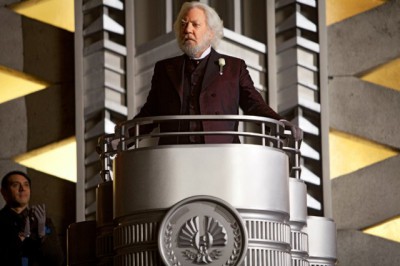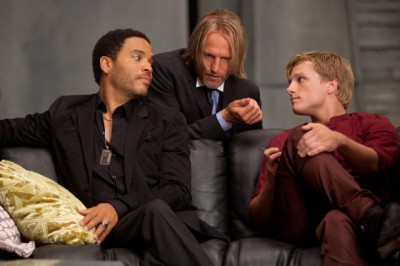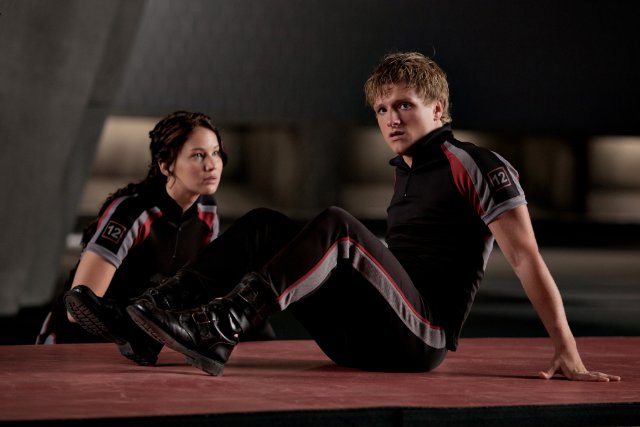“The Hunger Games” — a Film Review by Gary Chew
There is no doubt as I looked at the expression on Donald Sutherland’s face in the final shot of Gary Ross’s mucho promo-ed film, “The Hunger Games,” that it’s Franchise City for this sci fi in the woods teen caper that reviewers in my town were not offered an opportunity to see before it opened.
The heroine of the piece, Katniss Everdeen, is played by Jennifer Lawrence. Ms. Lawrence earned her way to prominence running beautiful Ozark mountains in the picture, “Winter’s Bone.” As Katniss, Jennifer is nearly a carbon copy of the hardscrabble Ree she played in the 2010 movie. Katniss can also kick ass with the best of them while maintaining a big heart for younger, underprivileged females
She does it in the future though, under the thumb of a nasty totalitarian society that, it’s implied, is the outcome of, I’m sorry to say, the American Experiment after something awful happening across North of America.
It looks as though Katniss and her nearly starving family live in a poverty-stricken coal mining town that might be called Dystopia, West Virginia. It’s located in District 12 of the dozen such regions of the nation now called Panem.

President Snow (Sutherland) is in charge of a motley society of people who look as though they’ve just been to a costume party for which Stanley Kubrick has provided everyone’s wardrobe (including makeup) a la “A Clockwork Orange.”
The important Panemians all seem to be decadent and inclined to bloodsport since “peace” has set in. And as (I’m guessing here) football is no longer played in the nation, people need their yearly Hunger Games to watch on a technologically advanced and intrusive television system.
Annually, each of the 12 districts must present a pair of young people (a male and female between 12 and 18) to take part in a survivalist fight-to-the-death among 11 other couples. Only one person gets to live…and does so, thereafter, with all the fame, assets and glory a great athlete enjoys.
The founding fathers of Panem want to keep the lower class from getting restive about their tough living conditions. They opine that if citizens in the Districts have someone to root for, it will keep them more disposed to hope and will reenforce their appreciation for how difficult it’s been for Panem to attain its world stature.
Katniss volunteers to take her little sister’s place when the younger girl is selected at random, as are all participants. Her name is Primrose. Willow Shields has the role.
The young man from District 12 who’s pulled into the Hunger Games is Peeta Mellark (Josh Hutcherson). He’s had a crush on Katniss for years. But she doesn’t know it. Being boy crazy doesn’t appear to be her thing.
Participants or “tributes” are taken to the fabulous Capital City for preparation and survival training. It also a time for them to get personal sponsors for provisions and other kinds of support in order to win the Hunger Game.

Among the mentors or trainers of the young people you’ll notice Woody Harrelson as Haymitch Abernathy and, of all people, Lenny Kravitz doing the role of Cinna.
The media are a big part of the yearly Panem Hunger Games, primarily through interview programs on television. Stanley Tucci, as Caesar Flickerman, damn near steals the film with his big-toothed impersonation of a smarmy, exploitative talk show star with a Bob Hope-ish “Monsieur Beaucaire” hairdo. Caesar’s co-host is called Claudius Templesmith (Toby Jones).
Is there a waft of Rome in all of this?
When the game begins, hidden television devices monitor the chase and mayhem…even a quiet, warm PG-13 scene between Katniss and Peeta holed up in a cave as Peeta nurses a leg wound.
Not much blood shows up in this game, however; it has that Steven Spielberg look to it, with added palsied cinematography to suggest chaos.
It occurred to me, in a crazy kind of way, as I sat watching “The Hunger Games,” to wonder if the Panem viewers continued looking at their TV screens when the game players went to “the bathroom” out there in their wooded combat zone. It’s the first time I’ve ever thought about such normal, mundane actions as that while seeing a supposedly heavy movie about an ugly future for mankind.
Orwell and Huxley caused me to think more about how awful it must be to not live one’s life without a great deal of freedom.
And speaking of the issues encountered in dystopian stories: other than providing some satisfaction for characters who have our sympathy in “The Hunger Games,” the film hasn’t a clue about what, if anything, can be done to disallow one segment of a population controlling the rest of that society.
Again, the subtle yet unsettling look in Donald Sutherland’s eyes regarding what he might do next to win his game tells me that everyone should be finding out soon enough.
I close these comments on “The Hunger Games” (which seems to go into extra innings; 2 hours 22 minutes worth) with a nasty headache, due to the film’s quaking cinematography that some think makes a movie better. I would give it a 7.2 on the Richter Shaky-Movie Scale. Any other numbers or amount of stars for this motion picture should come in well below that mark.
- Movie Review: ‘The Glorias’ - September 28, 2020
- Movie Review: ‘I’m Thinking of Ending Things’ - September 10, 2020
- Movie Review: ‘The Burnt Orange Heresy’ - August 31, 2020


